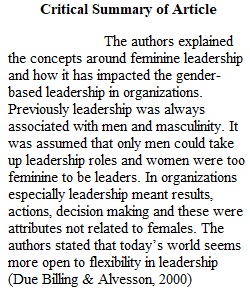


Q Annotated Bibliography 3 New Attempt • Due No Due Date • Points 30 • Submitting a file upload Due: Friday Module 3 To access the assignment instructions, click on the following document: Annotated Bibliography. Download Annotated Bibliography. You will find the articles for the annotated bibliographies at the bottom of the Module 3 Lecture. For reference, they are also listed here: Billing, Y. & Alvesson, M. (2000). Questioning the notion of feminine leadership: A critical perspective on the gender labelling of leadership. Gender, Work and Organization 7(3) 144-157. Javidan, M., Bullough, A., & Dibble, R. (2016). Mind the gap: Gender differences in global leadership self-efficacies. Academy of Management Perspectives, 30(1) 59-73. Liu, H. & Baker, C (2016). White knights: Leadership and the heroicisation of whiteness. Leadership, 12(4), 420-448. Patrick, H.A., & Kumar, V.R. (2012). Managing Workplace Diversity: Issues and Challenges, Sage Open, 1-15. DOI:10.1177/215824401244615 htpp://sgo.sagepub.com van Engen, M.L., van der Leeden, R. & Willemsen, T.M. (2001). Gender, context and leadership styles: A field study. Journal of Occupational and Organizational Psychology, 74(5) 581-598. You are only required to submit 2 annotations. To upload your completed work, click on the Start Assignment button and then the Submit Assignment button.
View Related Questions